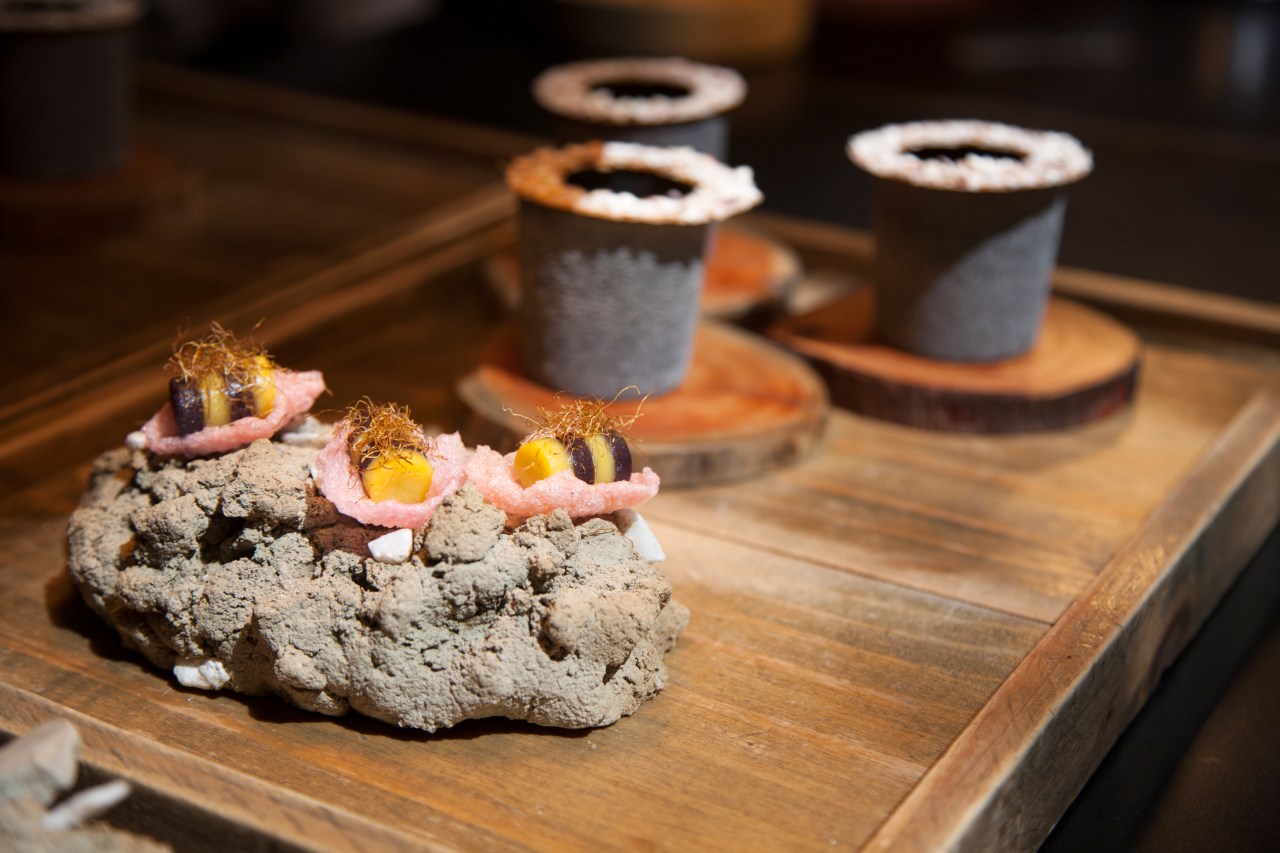Straddling the Amazon rainforest, the Andes mountains, and 1,500 miles of desert coast, Peru has a storied history, with signs of civilization that date back 8,000 years. The country’s rich biodiversity and the cultures and waves of migrants that have inhabited Peru have shaped its cuisine in profound ways.
Well before the Incas started their conquest of the Andes with the help of dried potatoes, the Moche and Chimú built complex trade networks and urban centers with tens of thousands of people. When the Spaniards arrived in 1531, they brought onions, limes, and livestock that soon entered mestizo kitchens. Meanwhile, West African slaves would go on to create some of the most beloved criollo — or mixed Spanish, African, and indigenous — dishes in Peru. Beginning in the mid-19th-century, tens of thousands of Chinese and Japanese migrants arrived, and they brought new cooking techniques that have molded Peruvian cuisine into what it is today. Here are the dishes that tell that story:

Huatía
Drive through any Andean valley from about May to June and you’ll notice smoking mounds of dirt in the middle of potato fields. These huatías, domed ovens created out of mud and stones, are a tribute to Mother Earth, or Pachamama, and represent the ascent of civilization in the Andes. Huatia is also the name of a simple dish of potatoes roasted in the oven. To cook huatia, a fire is built inside the oven and left until the walls are charred and near collapse. Tubers from that field — potatoes, oca, mashwa, or whatever else is grown there — are set inside. The oven is then used to bury the tubers, and the hot earth cooks them. It’s a cooking process that precedes the Incas. After an hour or so, the tubers are placed on a blanket, and everyone gathers around to eat. Someone might grind ají peppers and herbs like huacatay into uchucuta, a chile sauce. A fermented corn beer called chicha de jora is passed around as they eat.
Chuño
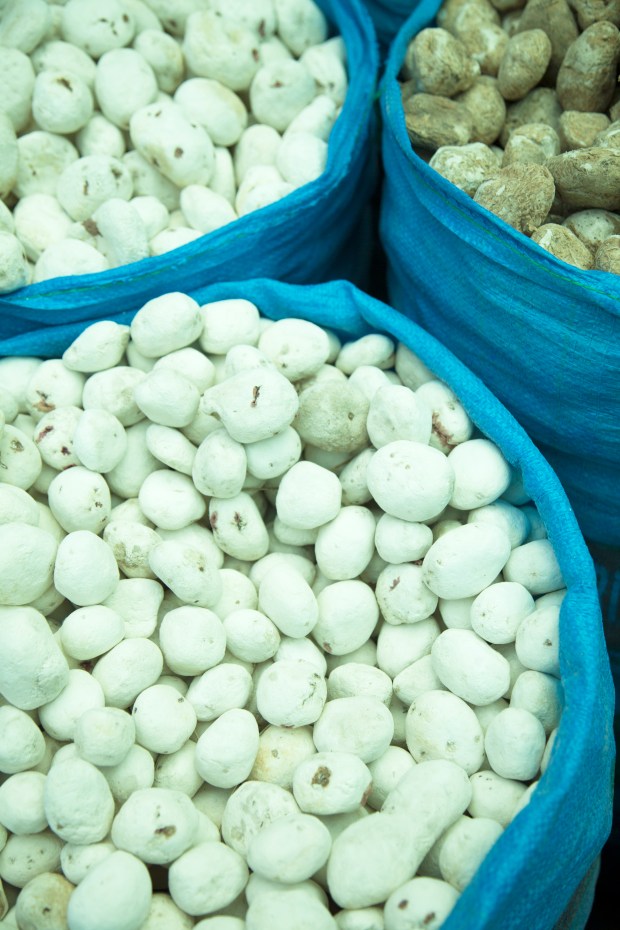
The Incas grew from a small tribe near Cusco into a vast civilization by the 13th century, becoming the largest pre-Columbian empire in the Western Hemisphere. At its peak, the Inca people numbered as many as 12 million and inhabited territory stretching 2,500 miles from north to south, almost the entire length of the Andes. To make this expansion possible, their armies needed food that could be stored for long periods. While there are several thousand varieties of potatoes that grow in the Andes, they are seasonal and last just a month or two after harvest, and llamas and alpacas could carry only so many potatoes over long distances. The warm days and frigid nights in the high Andes were ideal conditions for turning potatoes into chuño — a process in which they are repeatedly frozen, thawed, stomped on to remove the skins and liquid, and dried in the sun.
The shelf life of this natural form of freeze-dried potato, which can be white or black, depending on the process, can be years. Marching armies could carry them and keep them in qullqa, storehouses built along roads throughout the empire, along with beans, quinoa, and dried alpaca meat called charqui. The chuño could be rehydrated in stews or used to thicken sauces. To this day, chuño is widely consumed, and it is the signature ingredient in carapulcra, an adaptation of a traditional Andean dish in which it is paired with pork, peanuts, and ají panca.
Juanes
The Amazon rainforest covers about 60 percent of Peru, though it is home to just 5 percent of the population. Combining the basics of the Amazonian diet — fish, yuca, and plantains — which are wrapped in a bijao leaf and then boiled or grilled, the juane, a sort of jungle tamal, is the region’s most typical dish. It is something that can be taken on hunting trips or on visits to other communities. However, most juanes eaten today have been adapted to include other ingredients. For the most part, yuca has been replaced with rice, which was brought by the Chinese, and olives, brought by the Spanish, have been added. Even the name (a reference to San Juan Bautista, or St. John the Baptist) shows foreign influence. Every region in Peru’s Amazon has its own version, and variations may add ingredients like pork, heart of palm, peanuts, corn, eggs, chicken, and innards.
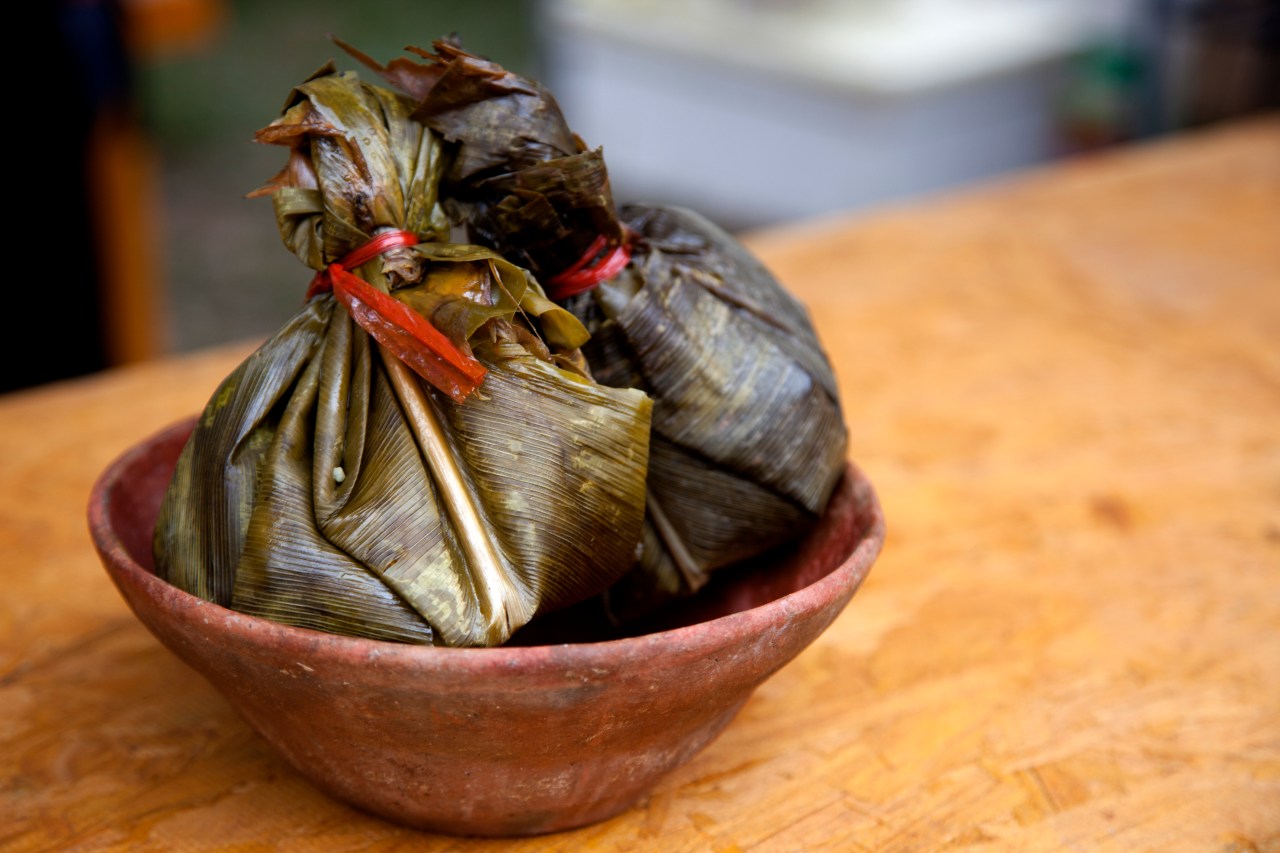
Quinotto
In 1980, a civil war began between Shining Path guerrillas and the government. Tens of thousands of people were killed over the next two decades. In the violence, Peruvian culture, including the cuisine, took a hit. Many regional ingredients were isolated from the rest of the country and forgotten. In the 1990s, as the war was winding down and the provinces started to open to the capital, Bernardo Roca Rey, the publisher of a Peruvian newspaper and an amateur cook, began experimenting with native Peruvian ingredients. At that time, many of these items had been forgotten and were looked down upon by many Peruvians. It was peasant food, many insisted, but when he created a quinotto, a risotto that replaced rice with quinoa, people began to take notice. One of those people was a young Cordon Bleu–trained chef in Lima named Gastón Acurio, who was making French food at the time at Astrid y Gastón, a restaurant he ran with his wife. He started creating more contemporary recipes using Peruvian ingredients, and Peruvian cuisine began attracting considerable international attention. For the first time in quite a while, Peru had something to be proud of.
Cebiche
When the Spanish first landed in Peru, in Tumbes at what is now the border with Ecuador, they found local populations eating fish marinated in tumbo, a kind of passionfruit. This was an early form of what would become Peru’s national dish, in which acid is used to coagulate proteins — a process akin to cooking. After the founding of Lima, colonial kitchens added Old World ingredients such as onion and bitter orange or limes into cebiche, more commonly spelled ceviche outside Peru. However, it was in the 20th century, when Japanese immigrants flocked to Peru, that the dish began to take on its modern form.
The Japanese had their own way of treating fish. First, they cut it into chunks. Then they reduced the contact time with the acid, from a few hours to just a few seconds, before serving. Ingredients may be tweaked, depending on the region, but cebicherías are more than just simple restaurants. They are lunchtime-only societal centers where families and friends gather, ordering from an array of seafood dishes as they catch up on the latest gossip. Other Japanese-influenced dishes soon joined ceviche on the Peruvian table — for example, tiradito (sashimi-thin slices of fish doused in a sauce with an ají amarillo base) and pulpo al olivo (octopus covered in a sauce made of black olives).
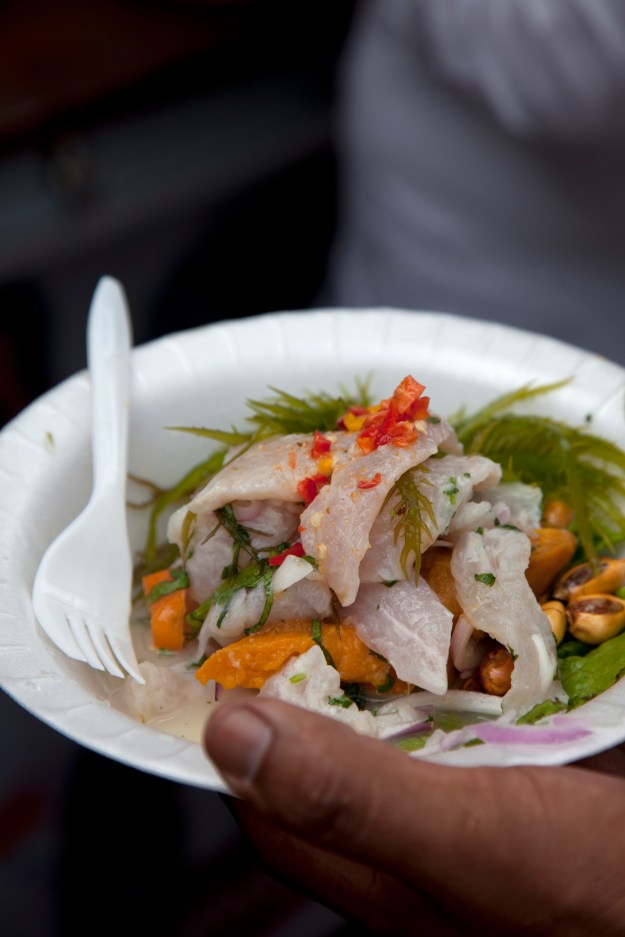
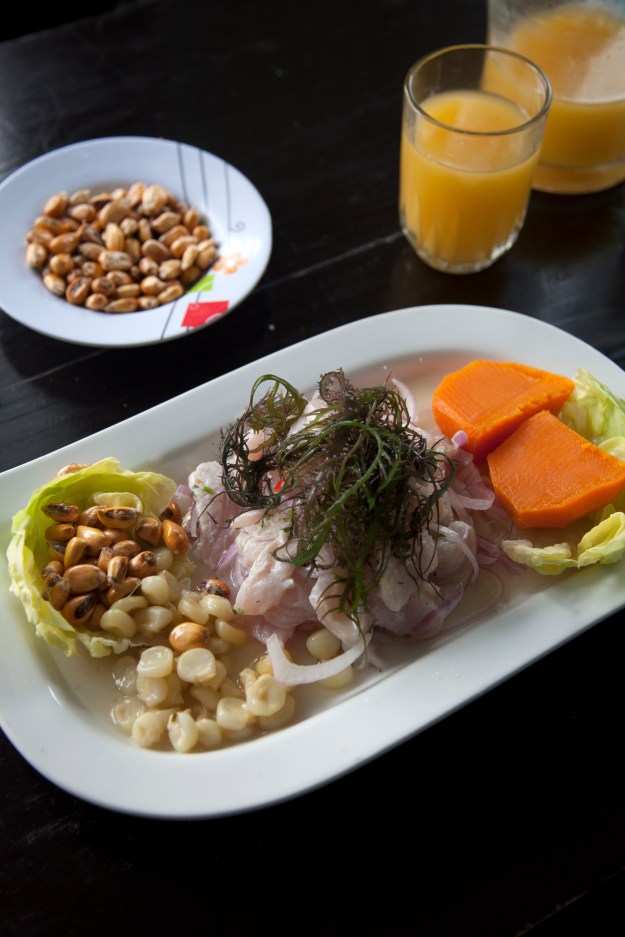
Anticuchos
A few hundred West African slaves arrived with the conquistadors. Larger numbers began arriving after the Spanish crown passed the New Laws of 1542 to regulate abuses by colonists against natives. Approximately 95,000 slaves arrived, and the last slave ship docked in 1850. Slavery was abolished in the country four years later. During that time, the slaves sustained the coastal haciendas. It was in those plantation kitchens that the slaves lived off leftovers. They did what they could to make them palatable with the ingredients they had around them. In the process, they created countless dishes called anticuchos that have become the backbone of the criollo recipe book. Chicken blood was fried and seasoned to make sangrecita. When a cow was slaughtered, they took the innards, including the heart, which they would cube and season with garlic, vinegar, cumin, and salt. They would then skewer the chunks on sugarcane and grill them over an open flame. According to Peruvian Ricardo Palma’s Tradiciones Peruanas, carretillas, or street carts, started to appear on Lima’s streets in the early 1830s, and they can still be found after dark around the city. Several of the carts have been in business for decades and have developed cult followings. Intestines, chicken gizzards, and other offal often share a grill. Anticuchos are usually served with tacu tacu (fried leftover rice and beans), boiled potato, corn, and an option of sauces made of ají peppers.
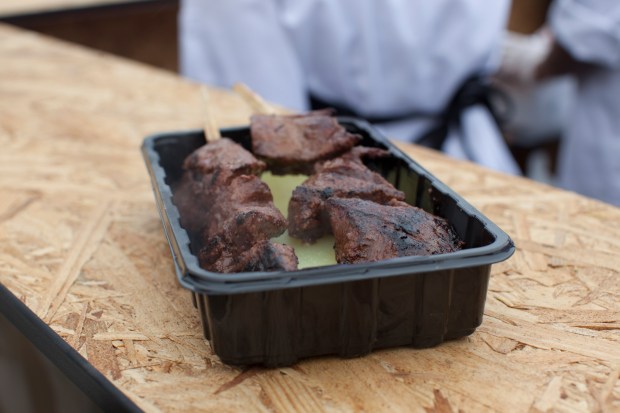
Cuy pekín
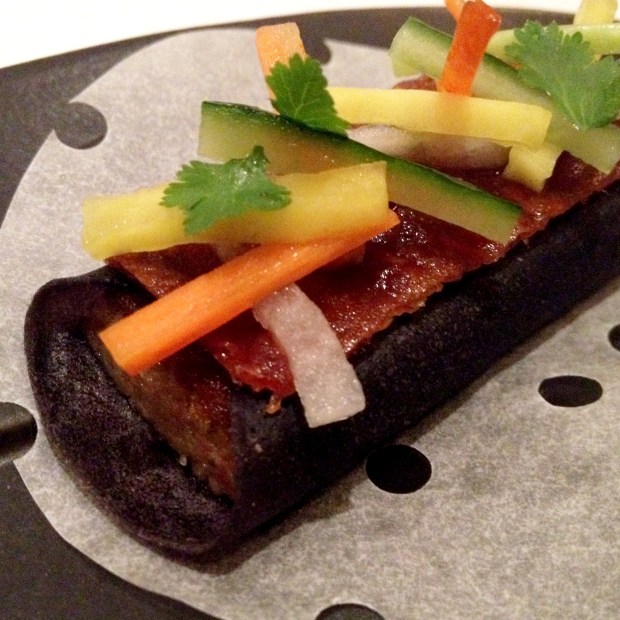
Acurio saw an opportunity to adapt traditional Peruvian food and bring it into a modern restaurant. He started with an updated cevicheria called La Mar in 2005. Soon after, he came up with other dishes based on regional Andean food — sandwiches, criollo, Italian Peruvian fusion, and the chifa. Restaurant branches began opening all over Latin America and eventually the U.S. and Europe, and Astrid y Gastón became a sort of idea lab. In 2011 a dish called cuy pekín emerged from the lab. Having seen ducks hanging in the windows of Lima’s Barrio Chino, Acurio decided to apply the same treatment to guinea pigs. The result, cuy pekín, is a chunk of roasted guinea pig with a crisp skin, which he sometimes serves on a bao, or steamed bun.
Lomo saltado

There are more than 1 million Peruvians of Chinese origin. Most of them have ancestors who came from Guangdong province beginning in the mid-19th century to work on coastal plantations after slavery was outlawed. In the 1920s, Lima’s Barrio Chino, or Chinatown, began to take shape, and that was when the first chifas, the Chinese restaurants now found in every corner of Peru, first opened. Even today they mostly serve standard Cantonese dishes. They helped inspire lomo saltado, one of the country’s most famous recipes. If you order lomo saltado at a chifa, it’s just stir-fried beef and onions, usually with a side of white rice. As the dish migrated outside the chifa and into the Peruvian kitchen over the decades, local ingredients like potatoes and ají amarillo were added. Through this dish, the use of the wok and soy sauce became standard in Peruvian cooking. So much so that today lomo saltado is made in most criollo restaurants and family homes.
Diversidad de maíz
Following the lead of Astrid y Gastón and Malabar, which launched serious Peruvian tasting menus in 2012, a handful of Peruvian restaurants found global acclaim for their intellectual approach in exploring Peru’s biological and cultural diversity. Several chefs now work in conjunction with conservationists and biologists to help create a demand for sustainable ingredients. This is exemplified by husband and wife Virgilio Martínez and Pia León of Central, who serve a menu in which each course uses ingredients from a specific ecosystem and altitude of Peru. One such dish, diversidad de maíz (diversity of corn), was introduced in 2014. It examines the wonders of corn grown in the coastal valleys from the north to the south of the country. It is a creation that explores not just the ecological value of the crop but also its hybridization and acclimatization at the hands of the farmers who grow it. In 2017 and 2018, Lima was the only city in the world to have two restaurants — Maido and Central — in the top 10 of the World’s 50 Best Restaurants list.
